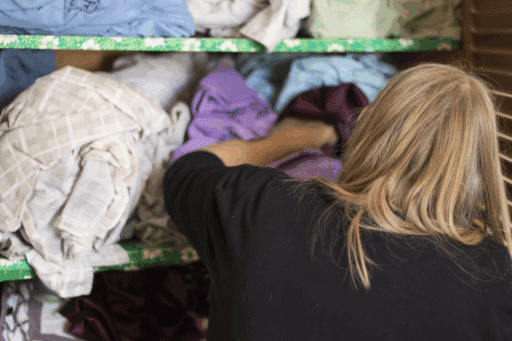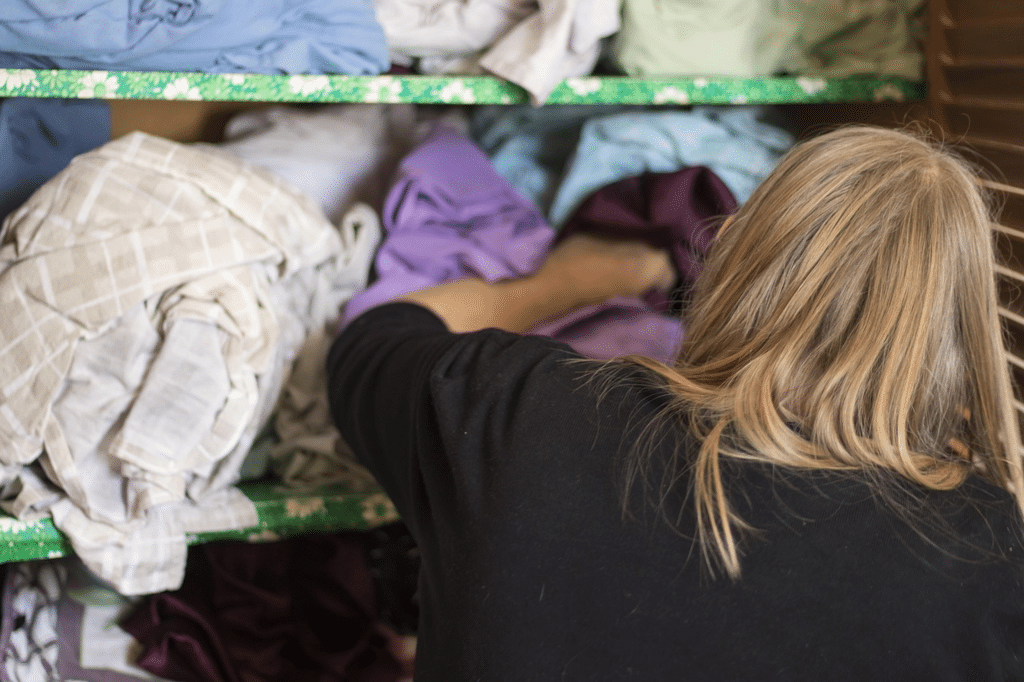Closet overhauls look dramatic on camera, but the real magic is what you remove—not just how neatly you line up hangers. If you want that calm, minimal closet to hold after the photos, you’ll need a plan for items that shouldn’t live there year-round. The goal isn’t fewer belongings; it’s better placement. Think of your closet as prime retail space. Only best-sellers deserve the front table.
What Belongs in Your Closet—and What Doesn’t
Start by setting a strict rule: the closet holds only what you wear weekly or need this month. Everything else gets re-routed. Daily drivers—work outfits, gym staples, sleepwear, the current season’s jackets—earn valuable rod space. If it’s a “someday” item, it’s a “not here” item. That single rule trims decision fatigue every morning and makes maintenance painless.
Where should the overflow go? Split it by time and purpose. Short-term overflow—like a week’s worth of laundry or a suitcase mid-unpack—can sit on a top shelf for a few days. Long-term overflow—holiday sweaters, tuxedos, graduation gowns, ski gear, maternity wear between pregnancies—belongs off-site. If you’re tight on square footage or sharing a small closet, consider storage rentals to park those infrequent pieces without sacrificing your daily setup. You’ll keep your closet lean while still keeping everything you own.
Don’t confuse “hard to replace” with “must stay nearby.” An heirloom coat, a tailored suit, or a delicate costume can live elsewhere as long as it’s cleaned, protected, and reachable within a day or two. The closet is a workstation, not a museum. Treat it like one.
Off-Site Candidates That Quietly Sabotage Minimalism
Start with seasonal clothing that carries bulk: wool coats, puffer jackets, heavy boots, and thick knitwear. These eat rod space and distort your closet’s proportions, making it feel full even when you wear only a fraction of what you see. Rotating them out with the seasons restores visual calm and protects fibers from crowding.
Next, remove occasion-specific pieces that you love but rarely touch: formalwear, costumes, team uniforms, church attire that’s not in rotation, and matching sets preserved for weddings or reunions. You’ll appreciate them more when they’re curated and easy to retrieve, not crushed between hoodies you reach for every day.
Round out the off-site box with “bulk but useful” categories. Extra bedding and guest towels, specialty handbags, luggage, baby gear waiting for the next growth spurt, and hobby items you use in cycles—think camping, snow sports, or ballroom shoes. When these are staged off-site, you don’t just gain space; you regain an accurate picture of what you actually wear, which stops reflexive “I have nothing to wear” shopping.
How To Prep Garments and Gear for Off-Site Storage
Clean first, always. Body oils and food residue invite pests and set stains. Launder washable items and dry-clean delicate fabrics before you pack them. Let everything breathe until fully dry; sealing in moisture is how mildew happens. Choose breathable garment bags for wool and silk, and sturdy, lidded bins for denim, cotton, and gear. Skip tight plastic wrap on natural fibers—it traps humidity. For handbags and shoes, stuff with clean, acid-free tissue to maintain shape.
Label like a store backroom. Use plain language you’ll understand in six months: “Winter Coats—Black Wool, Camel Maxi, Navy Puffer,” “Formal—Two Suits 40R, Navy Tux 40R,” “Guest Bedding—Queen Sheets x2, Duvet Insert.” Add a quick inventory note on the side of each bin and a photo in your phone. This five-minute step is what turns storage from “lost and forgotten” into “easy rotation.”
Mind the environment. Textiles and paper products hate damp conditions. Aim for low humidity (about 30–50%) to avoid mold, dust mites, and that musty smell that clings to fabric. The U.S. Environmental Protection Agency recommends keeping indoor humidity below 60%—ideally between 30% and 50%—to help prevent mold growth, a guideline worth following for any stored clothing or linens. A small hygrometer can help you verify conditions where you store your items, and a dehumidifier can stabilize tricky spaces.
Set Up a Minimalist Closet That Actually Works
Once the off-site boxes leave the room, reset the space like a boutique. Keep hangers uniform so garments sit at the same height; visual consistency is half the battle. Group by category and then by color in the order you actually choose outfits—perhaps tees, shirts, trousers, then light layers, then jackets. Reserve eye-level for your weekday rotation. When the things you wear most sit front and center, upkeep becomes automatic.
Set guardrails to keep clutter from creeping back. A simple one-in, one-out rule works if you enforce it at the rod, not the register: when a new blazer arrives, pick the old one to retire immediately to an off-site bin or donation bag. Use a “staging hanger” at the closet’s edge for anything you haven’t worn in 60 days. If it lingers there for another month without getting picked, it graduates to storage or resale. In a small space, discipline beats willpower; these micro-systems do the heavy lifting.
Schedule swaps instead of waiting until the weather forces your hand. A spring and fall rotation takes under an hour when your bins are clean and labeled. Pull the new season in, push the last season out, and do a quick audit while you’re at it. If winter coats come back with worn cuffs or missing buttons, fix them now—not when the first cold snap hits and your mending pile becomes an emergency.
Before-and-After, Minus the Backslide
A minimalist closet shouldn’t feel like a purge. It should feel like a daily shortcut. The “before” is crowded and indecisive; the “after” is decided in advance by what you choose to keep within arm’s reach. Off-site placement is what lets that decision stick. When infrequent pieces are packed clean, labeled clearly, and stored in a space with stable humidity, your closet becomes effortless to use and simple to reset.
Takeaway: keep only this month’s wardrobe in the closet, move the rest off-site with proper prep, and rotate on a set schedule—your minimal “after” will actually last.








